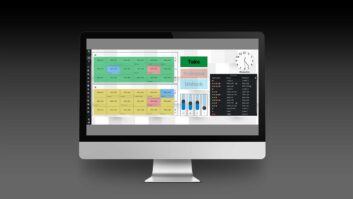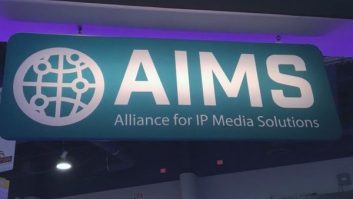What is the status of the IP transformation in our industry? While most have yet to deploy real-time IP systems that replace SDI, momentum is clearly growing.
Even though it has been less than a year since the SMPTE ST 2110 suite of standards for Professional Media Over Managed IP Networks has been published, ST 2110-based systems are deployed and on air. Broadcasters have used these systems in the production of major events, such as the recent royal wedding, the PyeongChang Olympics, Wimbledon, and the FIFA 2018 World Cup.
More than 200 installations have been successfully deployed using SMPTE ST 2110 and its predecessor, SMPTE ST 2022-6, which encapsulates SDI within IP. These include installations in Europe, Asia, Oceania, and North and South America. Broadcasters such as the BBC Wales, tpc Switzerland, Eurosport, Sky Italia, CCTV in China, Korean Broadcasting System, CNN, Fox Networks, NBC, and Brazil’s TV Globo and Globosat have all invested in IP as they build new plants and studios — enabled in part by the significant proliferation of SMPTE ST 2110-based equipment.
At the time of this writing, manufacturers from all over the world are flying to a qualification event in Germany, where we expect roughly 60 vendors to qualify for the third annual IP Showcase at IBC2018, all with SMPTE ST 2110-capable gear and across every major product category. Such an array of products from so many different vendors means that the SMPTE ST 2110 kit is becoming widely available, providing broadcasters with freedom of choice.
Why, though, are broadcasters choosing IP? Simply stated, it is because of the compelling benefits of IP-based systems.
Out of the 36 reference sites that AIMS will introduce in its “IP in Action” wall at IBC, roughly three quarters of them cited flexibility — particularly format flexibility — as a major benefit of their IP systems. In a world where the number of video formats has exploded, and no one can predict the future, IP has the port speed and expansion capability to handle HD, UHD, and higher bit depth in a far more elegant way than SDI. Arena TV, Timeline, and tpc are examples of companies that have seized on IP to build OB trucks that handle HD and UHD equally well without compromising on the number of cameras needed for major sporting events.
Scale is another often-cited benefit of IP. Using IP, NEP was able to create the equivalent of a 3000 x 3000 SDI router for the All England Lawn Tennis and Croquet Club by linking multiple IP OB trucks and flypacks together. This setup gave rights holders more access to signals from more courts than ever before. For the same reasons, IP is proving to be the technology of choice for many networks, as IP switches scale far higher than SDI routers and are much more compact for given switching capacity.
In addition to gaining the above benefits, other broadcasters have exploited IP for better resource sharing. As an example, NEP — both in the Netherlands and in Australia — has created central control rooms and equipment rooms that are connected to venues and studios across their respective countries. By eliminating the need to transport equipment to various venues, NEP can make more efficient use of that equipment and its creative staff.

For all the above reasons, IP is gaining significant momentum. Should we say, though, that IP is at a state of maturity in our industry? It depends. In terms of the base standards necessary to build reliable systems — the published standards of the SMPTE ST 2110 suite — yes, these standards are mature. Many of the most prestigious events in 2018 have been produced using SMPTE ST 2110-based systems.
However, from the perspective of complete adoption, we are still in an early stage. Estimates vary, but somewhere around 5 per cent to 10 per cent of broadcasters have replaced SDI with IP-based systems. Even with the great success IP has had in so many high-profile events and installations, the capital replacement cycle in our industry is relatively long. Moreover, the economic incentive to move to IP is proportional to the size of one’s installation, where benefits such as scale, long-term format flexibility, and resource sharing become more important with size. Those who are investing in IP for small systems tend to have a long-term vision for connecting those small systems together, piece by piece, to build their IP network over time.
The value proposition of IP is compelling today, and over time, I expect it to become even more compelling. The industry is now on the IT price curve. Price/performance of IP systems, which is already very good, will improve. New standards and open specifications will broaden the applicability and make system deployments simpler. SMPTE is in the process of drafting a new standard for the ST 2110 suite, SMPTE ST 2110-22, that will address transport of constant-bit-rate compressed video. This standard will greatly expand the addressable use cases for SMPTE ST 2110.
SMPTE is also in the final stages of completing SMPTE ST 2110-31, which will address transport of AES3 data, enabling carriage of formats such as Dolby-E in a SMPTE ST 2110 system. Importantly, the Advanced Media Workflow Association (AMWA) is developing a series of specifications covering device discovery and registration, connection management, audio channel mapping, and a common specification for event and tally notifications. These specifications will serve to make IP for broadcast more plug-and-play.
What is the status of the IP transformation in our industry? We have strong momentum and proven on-air systems across the world, and we have begun to see significant adoption — with much more adoption to come.
More information about the IBC IP Showcase can be found at www.ipshowcase.org. More information about AIMS can be found at www.aimsalliance.org.







